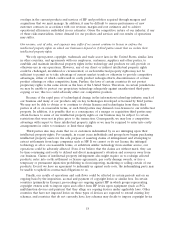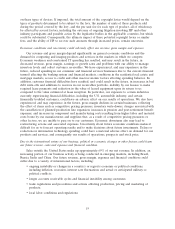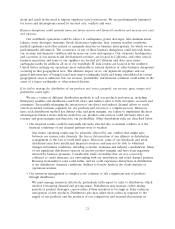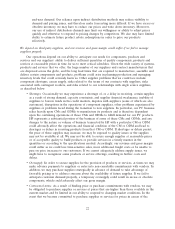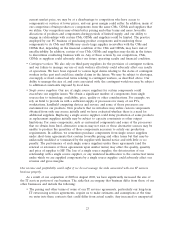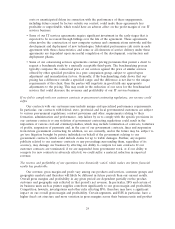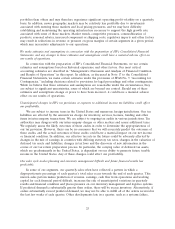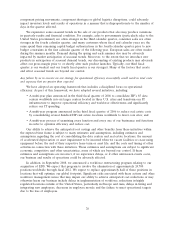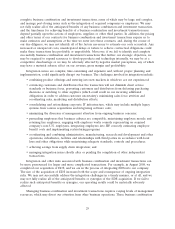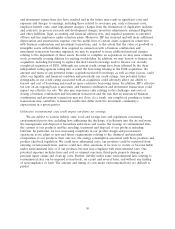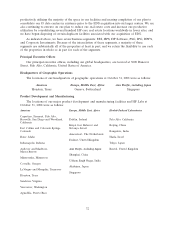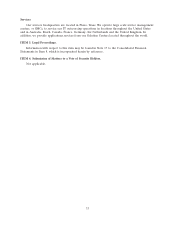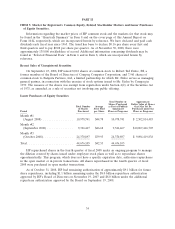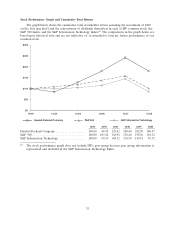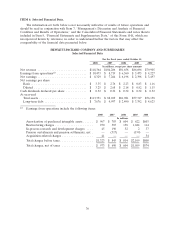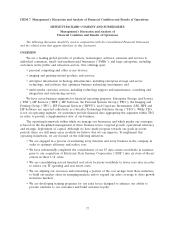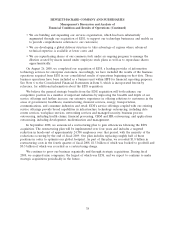HP 2008 Annual Report Download - page 34
Download and view the complete annual report
Please find page 34 of the 2008 HP annual report below. You can navigate through the pages in the report by either clicking on the pages listed below, or by using the keyword search tool below to find specific information within the annual report.General or industry-specific market conditions or stock market performance or domestic or
international macroeconomic and geopolitical factors unrelated to HP’s performance also may affect
the price of HP common stock. In particular, the stock market as a whole recently has experienced
extreme price and volume fluctuations that have affected the market price of many technology
companies in ways that may have been unrelated to those companies’ operating performance. For these
reasons, investors should not rely on recent trends to predict future stock prices, financial condition,
results of operations or cash flows. In addition, following periods of volatility in a company’s securities,
securities class action litigation against a company is sometimes instituted. If instituted against HP, this
type of litigation could result in substantial costs and the diversion of management time and resources.
System security risks and systems integration issues could disrupt our internal operations or information
technology services provided to customers, and any such disruption could reduce our expected revenue,
increase our expenses, damage our reputation and adversely affect our stock price.
Experienced computer programmers and hackers may be able to penetrate our network security
and misappropriate our confidential information or that of third parties, create system disruptions or
cause shutdowns. Computer programmers and hackers also may be able to develop and deploy viruses,
worms, and other malicious software programs that attack our products or otherwise exploit any
security vulnerabilities of our products. In addition, sophisticated hardware and operating system
software and applications that we produce or procure from third parties may contain defects in design
or manufacture, including ‘‘bugs’’ and other problems that could unexpectedly interfere with the
operation of the system. The costs to us to eliminate or alleviate security problems, bugs, viruses,
worms, malicious software programs and security vulnerabilities could be significant, and the efforts to
address these problems could result in interruptions, delays, cessation of service and loss of existing or
potential customers that may impede our sales, manufacturing, distribution or other critical functions.
Our outsourcing services business routinely processes, stores and transmits large amounts of data
for our clients, including sensitive and personally identifiable information. Breaches of our security
measures could expose us, our customers or the individuals affected to a risk of loss or misuse of this
information, resulting in litigation and potential liability for us and damage to the company’s brand and
reputation. Accordingly, we could lose existing or potential customers for outsourcing services or other
information technology solutions or incur significant expenses in connection with our customers’ system
failures or any actual or perceived security vulnerabilities in our products. In addition, the cost and
operational consequences of implementing further data protection measures could be significant.
Portions of our IT infrastructure also may experience interruptions, delays or cessations of service
or produce errors in connection with systems integration or migration work that takes place from time
to time. We may not be successful in implementing new systems and transitioning data, including our
current project to consolidate all of our worldwide IT data centers into six centers, which could cause
business disruptions and be more expensive, time consuming, disruptive and resource-intensive. Such
disruptions could adversely impact our ability to fulfill orders and interrupt other processes. Delayed
sales, lower margins or lost customers resulting from these disruptions have adversely affected in the
past, and in the future could adversely affect, our financial results, stock price and reputation.
Any failure by us to identify, manage, complete and integrate acquisitions, divestitures and other significant
transactions successfully could harm our financial results, business and prospects, and the costs, expenses
and other financial and operational effects associated with managing, completing and integrating
acquisitions may result in financial results that are different than expected.
As part of our business strategy, we frequently acquire complementary companies or businesses,
divest non-core businesses or assets, enter into strategic alliances and joint ventures and make
investments to further our business (collectively, ‘‘business combination and investment transactions’’).
In order to pursue this strategy successfully, we must identify suitable candidates for and successfully
28


